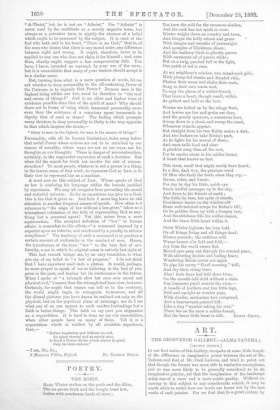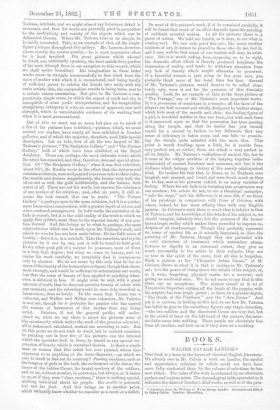ART.
THE GROSVENOR GALLERY.—(ALMA TADEMA.) [SECOND NOTICE.] IN our first notice of this Gallery, we spoke at some little length. of the difference in imaginative power between the art of Mr. Tadema and that of Mr. Cecil Lawson, and tried to point out that though the former was more able to realise his conceptions, and. so was more likely to be generally considered to be an imaginative painter, yet that the imagination of the landscape artist was of a rarer and a more poetic quality. Without re- curring to this subject to any considerable extent, it may be. worth while to notice how our words are borne out by the best works of each painter. For we find that to a great picture by Tadema, intricate, and we might almost say luxurious, detail is necessary, and that his works are generally good in proportion to the multiplicity and variety of the objects which can be delineated therein. Where Mr. Tadema tries to be simple, he is rarely successful. Take, as an example of this, all the single- figure pictures throughout this gallery. Mr. Lawson, however, shows exactly the reverse quality,—he is most impressive when he is least involved. His great pictures which abound in detail, are, artistically speaking, the least satisfactory portion of his work (though there is one exception to this remark, which we shall notice hereafter). His imagination in these latter works seems to struggle unsuccessfully to free itself from the mass of matter with which it is encumbered, and being hardly of sufficient power to subdue the details into unity with the main artistic idea, the composition results in being tame, and to a certain extent unmeaning. But give to Mr. Lawson a com- paratively simple scene, in which the aspect of earth and sky is susceptible of some poetic interpretation, and his imagination straightway interprets it with an amount of apparent ease and strength, which is unmistakable evidence of its working best when it is most unencumbered.
But of this we must say no more, but pass on to speak of .a few of the pictures here exhibited,—pictures which, we must remind our readers, have nearly all been exhibited in London -galleries, and of which the majority, therefore, need little special description. Let us take, first of all, the two largest of Mr. Tadema's pictures, "The Sculpture Gallery" and "The Picture 'Gallery," both of which have been exhibited at the Royal Academy. These are, perhaps, the most elaborate works which the artist has executed., and they, therefore, demand special atten- tion. Of "The Sculpture Gallery," when it was first exhibited, about 1875, Mr. Ruskin wrote to the effect that the textures and substances therein, were well painted in inverse ratio to their value; the marble and dresses magnificently, the bronze very well, the • silver not so well, the gold indifferently, and the human flesh -worst of all. These are not his words, but express the substance
• of one portion of his criticism ; and, after six years, it still re- mains the best remark that can be made. "The Picture Gallery" is perhaps open to the same criticism, but it is a quieter, more harmonious composition, with a greater depth of colour, and a less confused arrangement. In both works the execution of de- tails is superb, but it is the solid reality of the work to which we apply this epithet, more than to the especial beauty of any por- tion thereof. And this brings us to what is, perhaps, the most vital criticism which can be made upon Mr. Tadema's work, and which we wonder has not been made before. He has little sense of beauty,—there it is, in a nutshell. Take the assertion, and try his pictures by it one by one, and it will be found to hold good. Every other good gift of a painter he possesses, most of them in a very high degree ; but when we come to beauty, and ex- amine his work carefully, we invariably find it conspicuous only by absence. We do not mean by this only that he has no sense of the beauty of the human face or figure, though that shows most strongly, and would. be sufficient to substantiate our words, but that the sense of beauty of line, applied to anything what- -ever, is deficient in him. It might even be said, with a great amount of truth, that he does not perceive beauty of colour with any certainty, and his colouring would be more fitly described as harmonious, than as lovely. In the sense that Turner was a "colourist, and. Walker and Millais were colourists, Mr. Tadema is not one, though he is probably the painter who has carried the science of harmonies of tint further than any living artist. Painters, if not the general public, will under- stand us, when we say there is about his pictures none of the spontaneity which makes the work of the genuine coloarist ; all is restrained, calculated, worked out according to rule. But on this point we do not wish to dwell, but to restrict ourselves to pointing out in how few of his pictures can the interest 'which the spectator feels in them, be traced to any special im- pression of beauty which is contained therein. Is there a single man or woman that this artist has ever painted, whose face expresses to us anything of the inner character,—on which we -care to dwell to find out its meaning ? Passing emotions, such as the languor of girls in the bath, the excitement of the dance, the terror of the hidden Caner, the brutal mockery of the soldiers, and so on, without number, he pourtrays, but always, as it seems to us, as if they were "class emotions;" there is nothing special, 'nothing individual about his people. His marble is personal, but not his flesh. And this brings us to another point, which we hardly know whether to consider as a merit or a defect. In most of this painter's work, if it be examined carefully, it will be found that much of its effect depends upon the painting of suddenly arrested motion. In all his pictures there is a pause of action. We hold our breath, as it were, to see what is coming next. We can only point this out; like many another incident of art, it cannot be proved to those who do not feel it, and it may well be that many of our readers will deny its exist- ence. But it is worth noting, how, supposing us to be right, the dramatic effect which is thereby produced heightens the impression of reality, and tends to withdraw attention from any lack of beauty which might otherwise be perceived. If a beautiful woman is just going to box your ears, you. probably think more of her hand than her face. Several of Mr. Tadema's pictures would deserve to be called abso- lutely ugly, were it not for the presence of this dramatic quality. Look, for an example of this, at the large picture of "The Vintage," one of Mr. Tadema's most important works. It is a procession of musicians in a temple ; all the faces of the players are half covered and wholly disfigured by leather straps, which hide most of the mouth and chin ; the leading figure of a girl, is beautiful neither in face nor form, but with such force is it impressed upon us that the procession has been passing along the temple, and that its leader has just turned round for a second to beckon to her followers, that any' sense of deficiency is taken away, and. one falls to examin- ing the details, quite satisfied with the main idea. This point is worth dwelling upon a little, for it results from very perfect art, or rather, from art which is very perfect in all its details. Mr. Tadema's realisation of ancient life, has in it none of the vulgar qrtalities of the heaping together indis- criminately of ancient furniture and costumes, nor has it the dullness which belongs to history of the merely catalogueical kind. He realises the fact that in Rome, as in England, men laughed, and sneered, and loved, and were loved, much as they do to'day, and so his pictures exhibit to us many varieties of feeling. Where his art fails is in bringing into prominence any one emotion ; his actors do not, to use a theatrical metaphor, "take the stage," and his difference is at once felt, if we think of his paintings in comparison with those of GdrAme, with whom, indeed, he has more affinity than with any English painter. In Gerome's work there is much that is inferior to that of Tadema, and his knowledge of the details of his subject is, we should imagine, infinitely less ; but the pictures of the former have a tragic reality which makes them powerful to impress us, despite of all shortcomings. Though they probably represent no scene of ancient life as it actually happened, as does the painting of Mr. Tadema, though they are pervaded with a cold classicism of treatment which surrenders attrac- tiveness to dignity to an abnormal extent, they give so much personality to the actors in their subjects, they are so true to the spirit of the scene, that all else is forgotten. Such a picture as the "Cleopatra before Caesar," of M. Ger6me, shows us what it is that is lacking in Mr. Tadema's art; it is the power of rising above the details of his subject, of, as it were, forgetting physical truths for a moment, and. giving us emotional ones. We do not mean to say that to this there are no exceptions. The picture (small as it is) of Tarquinius Superbus cutting off the heads of the poppies with his sceptre, has true tragic power ; so have, in a greater degree, "The Death of the rirstborn " and the Ave, Ciosar." And yet it is curious, in looking at this last, to see how Mr. Tadema has failed to give to the subsidiary figures auy tragic intention, —the two soldiers and the discovered Closer are very fine, but in the crowd of faces on the left-hand of the picture, the inter- est fades away into nothing. These people are absolutely free from all emotion, and look on as if they were at a wedding.


































 Previous page
Previous page